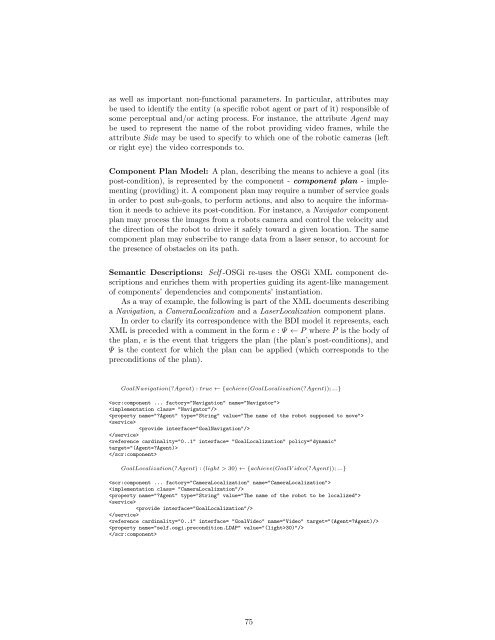Here - Agents Lab - University of Nottingham
Here - Agents Lab - University of Nottingham
Here - Agents Lab - University of Nottingham
You also want an ePaper? Increase the reach of your titles
YUMPU automatically turns print PDFs into web optimized ePapers that Google loves.
as well as important non-functional parameters. In particular, attributes maybe used to identify the entity (a specific robot agent or part <strong>of</strong> it) responsible <strong>of</strong>some perceptual and/or acting process. For instance, the attribute Agent maybe used to represent the name <strong>of</strong> the robot providing video frames, while theattribute Side may be used to specify to which one <strong>of</strong> the robotic cameras (leftor right eye) the video corresponds to.Component Plan Model: A plan, describing the means to achieve a goal (itspost-condition), is represented by the component - component plan - implementing(providing) it. A component plan may require a number <strong>of</strong> service goalsin order to post sub-goals, to perform actions, and also to acquire the informationit needs to achieve its post-condition. For instance, a Navigator componentplan may process the images from a robots camera and control the velocity andthe direction <strong>of</strong> the robot to drive it safely toward a given location. The samecomponent plan may subscribe to range data from a laser sensor, to account forthe presence <strong>of</strong> obstacles on its path.Semantic Descriptions: Self -OSGi re-uses the OSGi XML component descriptionsand enriches them with properties guiding its agent-like management<strong>of</strong> components’ dependencies and components’ instantiation.As a way <strong>of</strong> example, the following is part <strong>of</strong> the XML documents describinga Navigation, a CameraLocalization and a LaserLocalization component plans.In order to clarify its correspondence with the BDI model it represents, eachXML is preceded with a comment in the form e : Ψ ← P where P is the body <strong>of</strong>the plan, e is the event that triggers the plan (the plan’s post-conditions), andΨ is the context for which the plan can be applied (which corresponds to thepreconditions <strong>of</strong> the plan).GoalNavigation(?Agent) : true ← {achieve(GoalLocalization(?Agent)); ...}75


